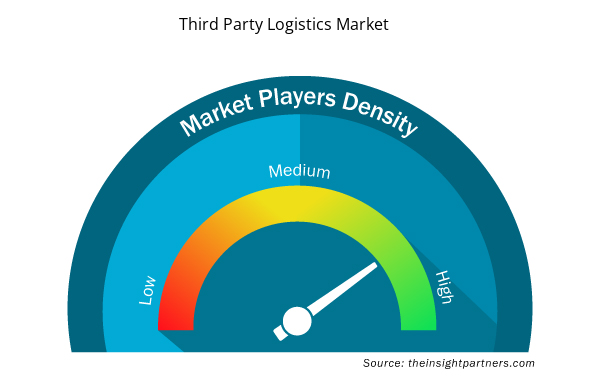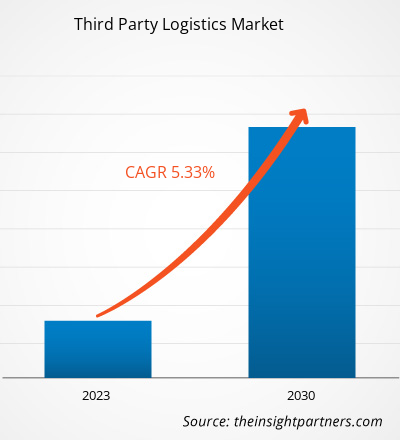2022 年第三方物流市场价值为 12731 亿美元,预计到 2030 年将达到 19291.8 亿美元;预计 2022-2030 年期间复合年增长率为 5.33%。
电子商务的日益普及可能仍将是市场的一个主要趋势。
第三方物流市场分析
电子商务的兴起以及当日或次日送达的需求推动了对最后一英里配送服务的需求。例如,亚马逊的 Prime 服务为快速配送设定了新标准,促使第三方物流公司调整其服务以满足这些期望。人们对环境问题和可持续性的意识日益增强,导致对环保物流解决方案的需求增加。第三方物流供应商正在采用电动汽车、优化路线以减少排放,并实施可持续的包装实践以满足消费者和监管部门的期望。
第三方物流市场概况
将制成品从工厂运输到仓库是整个 3PL 流程的第一阶段。一旦产品到达仓库或配送中心,3PL 业务就会存储产品。产品按照其 SKU 进行存储,每个 SKU 都有自己分配的存储位置。进入仓库的物品通常会在此时输入供应商的跟踪系统。软件集成有助于实现高效和有效的流程。
定制此报告以满足您的需求
您可以免费定制任何报告,包括本报告的部分内容、国家级分析、Excel 数据包,以及为初创企业和大学提供优惠和折扣
- 获取此报告的关键市场趋势。这个免费样品将包括数据分析,从市场趋势到估计和预测。
第三方物流市场驱动因素和机遇
管理产品季节性变化以利于市场
第三方物流公司拥有扩展的资源网络,支持主要公司以经济高效的方式高效扩张。此外,第三方物流公司可以为季节性库存或新产品发布提供足够的资源和服务弹性。许多企业的客户倾向都会出现季节性变化,管理这种波动以保持效率并满足需求成为关键。
软件解决方案的应用和大数据分析的采用
采用支持 RFID 的设备还有望存储数据以便于运输,从而简化产品的跟踪和识别。与运输管理系统相关的软件将减少效率低下和成本。此外,在仓库管理系统通信中使用语音识别软件将有助于订单周转和库存记录,同时降低员工培训需求。除此之外,第三方物流组织对基于云的技术的接受将通过认识到客户访问的需求来响应需求,使他们能够更好地应对季节性趋势。
第三方物流市场报告细分分析
有助于第三方物流市场分析的关键部分是运输方式、服务和最终用户。
- 根据运输方式,第三方物流市场分为公路、铁路、水路和航空。2023 年,公路运输占据了较大的市场份额。
- 根据服务,第三方物流市场分为国际运输、仓储、国内运输、库存管理等。国内运输部门在 2023 年占据了更大的市场份额。
- 根据最终用户,第三方物流市场分为汽车、医疗保健、零售、消费品和其他。其他部分在 2023 年占据了更大的市场份额。
第三方物流市场份额按地区分析
第三方物流市场报告的地理范围主要分为五个区域:北美、亚太、欧洲、中东和非洲、南美和中美。
第三方物流市场报告的范围包括北美(美国、加拿大和墨西哥)、欧洲(俄罗斯、英国、法国、德国、意大利和欧洲其他地区)、亚太地区(韩国、印度、澳大利亚、日本、中国和亚太地区其他地区)、中东和非洲(沙特阿拉伯、南非、阿联酋和中东和非洲其他地区)以及南美洲和中美洲(阿根廷、巴西和南美洲和中美洲其他地区)。就收入而言,亚太地区在 2023 年占据了第三方物流市场份额的主导地位。欧洲是全球第三方物流市场的第二大贡献者,其次是北美。
第三方物流市场区域洞察
Insight Partners 的分析师已详细解释了预测期内影响第三方物流市场的区域趋势和因素。本节还讨论了北美、欧洲、亚太地区、中东和非洲以及南美和中美洲的第三方物流市场细分和地理位置。

- 获取第三方物流市场的区域具体数据
第三方物流市场报告范围
| 报告属性 | 细节 |
|---|---|
| 2022 年市场规模 | 12731亿美元 |
| 2030 年市场规模 | 19291.8亿美元 |
| 全球复合年增长率(2022 - 2030 年) | 5.33% |
| 史料 | 2020-2021 |
| 预测期 | 2023-2030 |
| 涵盖的领域 | 按运输方式
|
| 覆盖地区和国家 | 北美
|
| 市场领导者和主要公司简介 |
|
市场参与者密度:了解其对商业动态的影响
第三方物流市场正在快速增长,这得益于最终用户需求的不断增长,而这些需求又源于消费者偏好的不断变化、技术进步以及对产品优势的认识不断提高等因素。随着需求的增加,企业正在扩大其产品范围,进行创新以满足消费者的需求,并利用新兴趋势,从而进一步推动市场增长。
市场参与者密度是指在特定市场或行业内运营的企业或公司的分布情况。它表明在给定市场空间中,相对于其规模或总市场价值,有多少竞争对手(市场参与者)存在。
在第三方物流市场运营的主要公司有:
- 基华物流
- 联邦快递
- 催办者
- 顺丰物流
- 马士基物流
免责声明:上面列出的公司没有按照任何特定顺序排列。

- 了解第三方物流市场顶级关键参与者概况
第三方物流市场新闻和最新发展
第三方物流市场通过收集一手和二手研究后的定性和定量数据进行评估,其中包括重要的公司出版物、协会数据和数据库。以下列出了第三方物流市场的一些发展情况:
- 全球领先的物流服务提供商之一 DB Schenker 和领先的运力解决方案提供商 USA Truck 达成协议,根据该协议,DB Schenker 将以每股 31.72 美元的现金收购 USA Truck 普通股的所有流通股。此次交易使 USA Truck 损失约 4.35 亿美元,包括承担的现金和债务。(来源:DB Schenker,新闻稿,2022 年 7 月)
- 全球领先的物流公司德国邮政敦豪集团今天宣布,将于 2023 年 7 月 1 日将公司名称更改为“DHL 集团”。新名称反映了集团过去几年经历的转型,并赞扬了集团专注于国内和国际物流活动作为未来增长的动力。(来源 DHL 集团,新闻稿,2023 年 7 月)
第三方物流市场报告范围和交付成果
“第三方物流市场规模和预测(2020-2030)”报告对以下领域进行了详细的市场分析:
- 范围内涵盖的所有主要细分市场的全球、区域和国家层面的第三方物流市场规模和预测
- 第三方物流市场趋势以及市场动态,如驱动因素、限制因素和关键机遇
- 详细的 PEST 和 SWOT 分析
- 第三方物流市场分析涵盖主要市场趋势、全球和区域框架、主要参与者、法规和最新市场发展
- 行业格局和竞争分析,涵盖市场集中度、热点图分析、知名参与者以及第三方物流市场的最新发展
- 详细的公司简介
- 历史分析(2 年)、基准年、预测(7 年)及复合年增长率
- PEST 和 SWOT 分析
- 市场规模价值/数量 - 全球、区域、国家
- 行业和竞争格局
- Excel 数据集


- Employment Screening Services Market
- Medical Audiometer Devices Market
- Photo Editing Software Market
- Sexual Wellness Market
- Asset Integrity Management Market
- Quantitative Structure-Activity Relationship (QSAR) Market
- Molecular Diagnostics Market
- Real-Time Location Systems Market
- Batter and Breader Premixes Market
- Water Pipeline Leak Detection System Market

Report Coverage
Revenue forecast, Company Analysis, Industry landscape, Growth factors, and Trends

Segment Covered
This text is related
to segments covered.

Regional Scope
North America, Europe, Asia Pacific, Middle East & Africa, South & Central America

Country Scope
This text is related
to country scope.
常见问题
Asia Pacific dominated the third party logistics market in 2022.
The investment in research & development by manufacturers is the future trend of the third party logistics market.
US$ 1929.18 billion estimated value of the third party logistics market by 2030.
6.6% is the expected CAGR of the third party logistics market.
DHL Group, Kuehne + Nagel International AG, DB Schenker, C.H. Robinson Worldwide Inc., DSV AS, Sinotrans Ltd., Giodis SA, United Parcel Service Inc., XPO Inc., Torello Transpoti Srl are some of the leading players in the market.
Trends and growth analysis reports related to Automotive and Transportation : READ MORE..
The List of Additional Companies - Third party logistics market
- CEVA Logistics
- FedEx
- Expeditors
- SF Logistics
- Maersk Logistics
- Kintetsu World Express
- Yusen Logistics
- Toll Group
- Hellmann Worldwide Logistics
- Penske Logistics
The Insight Partners performs research in 4 major stages: Data Collection & Secondary Research, Primary Research, Data Analysis and Data Triangulation & Final Review.
- Data Collection and Secondary Research:
As a market research and consulting firm operating from a decade, we have published and advised several client across the globe. First step for any study will start with an assessment of currently available data and insights from existing reports. Further, historical and current market information is collected from Investor Presentations, Annual Reports, SEC Filings, etc., and other information related to company’s performance and market positioning are gathered from Paid Databases (Factiva, Hoovers, and Reuters) and various other publications available in public domain.
Several associations trade associates, technical forums, institutes, societies and organization are accessed to gain technical as well as market related insights through their publications such as research papers, blogs and press releases related to the studies are referred to get cues about the market. Further, white papers, journals, magazines, and other news articles published in last 3 years are scrutinized and analyzed to understand the current market trends.
- Primary Research:
The primarily interview analysis comprise of data obtained from industry participants interview and answers to survey questions gathered by in-house primary team.
For primary research, interviews are conducted with industry experts/CEOs/Marketing Managers/VPs/Subject Matter Experts from both demand and supply side to get a 360-degree view of the market. The primary team conducts several interviews based on the complexity of the markets to understand the various market trends and dynamics which makes research more credible and precise.
A typical research interview fulfils the following functions:
- Provides first-hand information on the market size, market trends, growth trends, competitive landscape, and outlook
- Validates and strengthens in-house secondary research findings
- Develops the analysis team’s expertise and market understanding
Primary research involves email interactions and telephone interviews for each market, category, segment, and sub-segment across geographies. The participants who typically take part in such a process include, but are not limited to:
- Industry participants: VPs, business development managers, market intelligence managers and national sales managers
- Outside experts: Valuation experts, research analysts and key opinion leaders specializing in the electronics and semiconductor industry.
Below is the breakup of our primary respondents by company, designation, and region:

Once we receive the confirmation from primary research sources or primary respondents, we finalize the base year market estimation and forecast the data as per the macroeconomic and microeconomic factors assessed during data collection.
- Data Analysis:
Once data is validated through both secondary as well as primary respondents, we finalize the market estimations by hypothesis formulation and factor analysis at regional and country level.
- Macro-Economic Factor Analysis:
We analyse macroeconomic indicators such the gross domestic product (GDP), increase in the demand for goods and services across industries, technological advancement, regional economic growth, governmental policies, the influence of COVID-19, PEST analysis, and other aspects. This analysis aids in setting benchmarks for various nations/regions and approximating market splits. Additionally, the general trend of the aforementioned components aid in determining the market's development possibilities.
- Country Level Data:
Various factors that are especially aligned to the country are taken into account to determine the market size for a certain area and country, including the presence of vendors, such as headquarters and offices, the country's GDP, demand patterns, and industry growth. To comprehend the market dynamics for the nation, a number of growth variables, inhibitors, application areas, and current market trends are researched. The aforementioned elements aid in determining the country's overall market's growth potential.
- Company Profile:
The “Table of Contents” is formulated by listing and analyzing more than 25 - 30 companies operating in the market ecosystem across geographies. However, we profile only 10 companies as a standard practice in our syndicate reports. These 10 companies comprise leading, emerging, and regional players. Nonetheless, our analysis is not restricted to the 10 listed companies, we also analyze other companies present in the market to develop a holistic view and understand the prevailing trends. The “Company Profiles” section in the report covers key facts, business description, products & services, financial information, SWOT analysis, and key developments. The financial information presented is extracted from the annual reports and official documents of the publicly listed companies. Upon collecting the information for the sections of respective companies, we verify them via various primary sources and then compile the data in respective company profiles. The company level information helps us in deriving the base number as well as in forecasting the market size.
- Developing Base Number:
Aggregation of sales statistics (2020-2022) and macro-economic factor, and other secondary and primary research insights are utilized to arrive at base number and related market shares for 2022. The data gaps are identified in this step and relevant market data is analyzed, collected from paid primary interviews or databases. On finalizing the base year market size, forecasts are developed on the basis of macro-economic, industry and market growth factors and company level analysis.
- Data Triangulation and Final Review:
The market findings and base year market size calculations are validated from supply as well as demand side. Demand side validations are based on macro-economic factor analysis and benchmarks for respective regions and countries. In case of supply side validations, revenues of major companies are estimated (in case not available) based on industry benchmark, approximate number of employees, product portfolio, and primary interviews revenues are gathered. Further revenue from target product/service segment is assessed to avoid overshooting of market statistics. In case of heavy deviations between supply and demand side values, all thes steps are repeated to achieve synchronization.
We follow an iterative model, wherein we share our research findings with Subject Matter Experts (SME’s) and Key Opinion Leaders (KOLs) until consensus view of the market is not formulated – this model negates any drastic deviation in the opinions of experts. Only validated and universally acceptable research findings are quoted in our reports.
We have important check points that we use to validate our research findings – which we call – data triangulation, where we validate the information, we generate from secondary sources with primary interviews and then we re-validate with our internal data bases and Subject matter experts. This comprehensive model enables us to deliver high quality, reliable data in shortest possible time.


 获取此报告的免费样本
获取此报告的免费样本